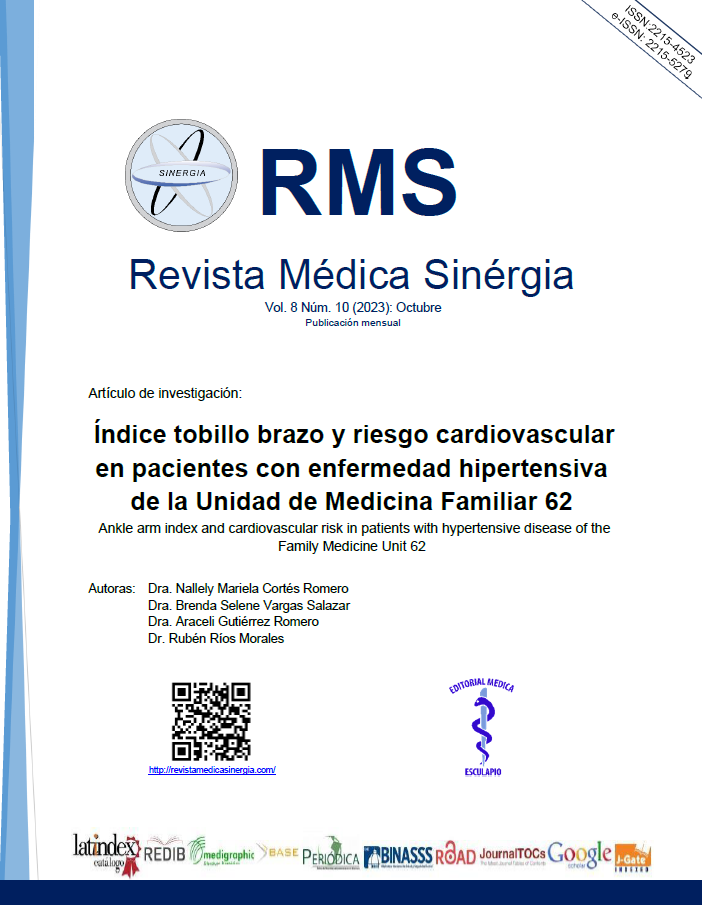Abstract
Background: The ankle brachial index is a non-invasive measure, simple and easy to measure in the doctor's office, it is the result of dividing the systolic blood pressure of each ankle into a higher value of any systolic blood pressure of the brachial arteries. An ankle brachial index of less than 0.9 is associated with a higher incidence of coronary and cerebrovascular artery complications, leading to a high risk of cardiovascular mortality.
Objective: To estimate the relationship between ankle-brachial index and cardiovascular risk in patients with hypertensive disease.
Material and methods: Type of study: Observational, analytical, transversal and prolective. Formula used for sample calculation: Finite formula. Calculated sample: 363 patients. Sampling: Simple random. Inclusion criteria: Included are those patients enrolled in this unit, aged between 45-85 years. The Excel 2016 package was used. Descriptive statistics were applied, with SPSS v25® software.
Results: In the present research work, the association between the ankle-brachial index and cardiovascular risk in patients with hypertensive disease was analyzed (p=0.017).
Conclusions: The prevalence found in our study sample is appreciably lower than that described in the literature for patients with hypertensive disease of comparable age, this due to the fact that our study has several limitations such as: the sample size which was smaller than that of previously conducted studies, and to the exclusion of subjects with a higher risk of PAD, since the incidence rates of pathological ITB appear higher in patients who smoke, followed by those with dyslipidemia and diabetes.
Keywords
References
Dávila Cervantes C. Tendencia e impacto de la mortalidad por enfermedades cardiovasculares en México. Revista Cubana de Salud Pública [Internet]. 2019 [citado el 20 mayo 2023];45(4):1081. Disponible en: https://www.scielosp.org/pdf/rcsp/2019.v45n4/e1081/es
Lozano F. Breve historia del índice tobillo/brazo (ITB). Revista Angiología [Internet]. 2021[citado el 20 mayo 2023];73(6):299-301. Disponible en: file:///C:/Users/nalle/Downloads/MA-REV-00308.pdf
Antezana G, Ayala Z, Velázquez M. Índice tobillo brazo como determinante de enfermedad arterial obstructiva periférica en adultos mayores. Gaceta Médica Bolivia [Internet]. 2021[citado el 20 mayo 2023];44(2):162-166. Disponible en: http://www.scielo.org.bo/pdf/gmb/v44n2/1012-2966-gmb-44-02-162.pdf
Zavala R, Rivera M, Sánchez M, De la Mata M. Prevalencia de factores y estratificación de riesgo cardiovascular en personal que labora en una Unidad de Medicina Familiar. Revista Atención Familiar [Internet]. 2019[citado el 20 mayo 2023];26(4):129-133. Disponible en: https://www.medigraphic.com/pdfs/atefam/af-2019/af194c.pdf
Daniel C, Kristel A, Fabio S, Alison R, Ernesto L, María V, et al. factores de riesgo cardiovascular. Revista Ciencia y Salud: Integrando Conocimientos [Internet]. 2020[citado el 20 mayo 2023];1(4). Disponible en: https://revistacienciaysalud.ac.cr/ojs/index.php/cienciaysalud/article/view/108/189
Enrique A, Blanca M, Teresa G, Cristina Y, Begoña P, Raúl J, Sandra G, et al. Prevalencia de sobrepeso/obesidad y su asociación con diabetes, hipertensión, dislipidemia y síndrome metabólico: estudio transversal de una muestra de trabajadores en Aragón, España. Revista Nutrición Hospitalaria [Internet]. 2019[citado el 20 mayo 2023];36(1):51-59. Disponible en: https://scielo.isciii.es/pdf/nh/v36n1/1699-5198-nh-36-01-00051.pdf
Guevara V, Ramírez R, Cárdenas V, Durán B, Gutiérrez V, et al. Perception of Cardiovascular Risk and use of technologies in Health in Adults with obesity. Quarterly Electronic Journal of Nursing [Internet]. 2019[citado el 20 mayo 2023];56:258-269. Disponible en: https://scielo.isciii.es/pdf/eg/v18n55/en_1695-6141-eg-18-55-246.pdf
Francisco J, Redondo F, Subiranab I, Baena J, Ramos R, Canchoe B, et al. Importancia pronóstica de la enfermedad arterial periférica diagnosticada mediante el índice tobillo-brazo en población general española. Revista de Atención Primaria [Internet]. 2020[citado el 20 mayo 2023];52(9):627-636. Disponible en: https://pdf.sciencedirectassets.com
Marco A. Almazán-Ávila. Cardiovascular risk factors in young Mexican Adults. Archivo Cardiología México [Internet]. 2020[citado el 20 mayo 2023];90(4). Disponible en: https://www.scielo.org.mx/pdf/acm/v90n4/1665-1731-acm-90-4-427.pdf
Lorente A, Rajjoub E, Mahdi A, Martínez R, Zamorano J. Factores de riesgo cardiovascular. Revista Medicine [Internet]. 2021[citado el 20 mayo 2023];13(36):2071-80. Disponible en: https://residenciamflapaz.com/Articulos%20Residencia%2017/391%20Factores%20de%20riesgo%20cardiovascular.pdf
Cervilla Suárez, Muñoz Cobos, Gracia Ruiz, Gálvez Alcaraz. Alteración del ITB en pacientes con riesgo de enfermedad arterial periférica en atención primaria. Frecuencias y factores asociados. Revista Medicina Familiar Andalucía [Internet]. 2022[citado el 20 mayo 2023];23(2):115-119. Disponible en: https://www.samfyc.es/wp-content/uploads/2023/04/v23n2_04_original_alteracionITB.pdf
Bolaños I, Chaves A, Gallón L, Ibáñez M, López H. Enfermedad arterial periférica en miembros inferiores. Revista medicina legal de Costa Rica [Internet]. 2019[citado el 20 mayo 2023];36(1):85-89. Disponible en: https://www.scielo.sa.cr/pdf/mlcr/v36n1/2215-5287-mlcr-36-01-84.pdf
Arias F, Benalcázar S, Bustamante B, Esparza J, López A, Maza G, Medin L, et al. Diagnóstico y tratamiento de enfermedad vascular periférica. Angiología [Internet]. 2022[citado el 20 mayo 2023];74(6):292-304. Disponible en: https://scielo.isciii.es/pdf/angiologia/v74n6/0003-3170-angiologia-74-06-292.pdf
Revueltas Agüero, Valdés González, Serra Larín, Suárez Medina, Ramírez Sotolongo, et al. Evaluación del riesgo cardiovascular en una muestra poblacional con dos tablas predictivas en La Habana. Revista Cubana de Medicina General Integral [Internet]. 2022[citado el 20 mayo 2023];38(1):1650. Disponible en: http://scielo.sld.cu/pdf/mgi/v38n1/1561-3038-mgi-38-01-e1650.pdf
Baglietto H, Mateos B, Nava S, Rodríguez G, Rodríguez W. Nivel de conocimiento en hipertensión arterial en pacientes con esta enfermedad de la Ciudad de México. Medicina Interna México [Internet]. 2020[citado el 20 mayo 2023];36(1):1-14. Disponible en: https://www.medigraphic.com/pdfs/medintmex/mim-2020/mim201b.pdf
Giorgiet G, Yamila L, Grettell G, Dailenys G, Yordanis F, Ariel S, et al. Hypertension-altered waist phenotype and its association with components of the metabolic syndrome in managers. End Magazine [Internet]. 2020 [citado el 20 mayo 2023];10(2). Disponible en: https://www.medigraphic.com/pdfs/finlay/fi-2020/fi202g.pdf
Organización Mundial de la Salud. Plan de acción mundial para la prevención y control de las enfermedades no transmisibles 2013-2020. [citado el 20 mayo 2023]. Disponible en: https://www.paho.org/hq/dmdocuments/2015/plan-accion-prevencion-control-ent-americas.pdf

This work is licensed under a Creative Commons Attribution-NonCommercial 4.0 International License.
Copyright (c) 2023 Array


